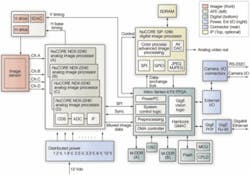Consumer ICs improve GigE-camera performance
Andrew Wilson, Editor, [email protected]
Semiconductor vendors, intent on producing low-cost, high-performance ASICs for volume applications, have over the years produced highly integrated devices designed primarily for broadcast television and digital photography. By leveraging the power of these devices, developers of image-processing peripherals have both lowered the cost and increased the performance of their products.
More than a decade ago, companies such as Philips Semiconductors (now NXP Semiconductors; Eindhoven, The Netherlands; www.nxp.com) offered a range of products mainly designed for decoding standard NTSC, PAL, and SECAM signals. Now, with the popularity of digital cameras and video systems, newer companies such as NuCORE Technology (San Jose, CA, USA; www.nucoretech.com) are delivering sophisticated analog and digital ASICs that perform many of the functions for digital cameras for the machine-vision and video surveillance markets.
According to Steve Kinney, product manager at JAI (Glostrup, Denmark; www.jai.com), his company will be using these products in its next generation of Camera Link- and GigE-based cameras set to debut in May 2007. “Initially,” says Kinney, “the company will introduce a range of products around the same basic platform. This will consist of a modular image-capture front end that will support a number of popular CCD imagers from Kodak Image Sensor Solutions (Rochester, NY, USA; www.kodak.com) and Sony Semiconductor (San Jose, CA, USA; products.sel.sony.com/semi/ccd.html).
JAI has chosen the NuCORE NDX-2240 as an analog front end (AFE) to these imagers, a device that includes a built-in programmable timing generator, correlated double sampling (CDS), 22-bit ADC, programmable gain amplifier, and 16-region “pre-knee” gamma adjuster. According to Yutaka Hirono, principle engineer with JAI, the ability of the AFE to offer master-slave support for many devices will allow the company to use the AFE in a number of configurations to support a range of multitap image sensors.
In JAI camera designs, these AFEs will be tightly coupled to NuCORE’s SiP-1280, a digital image processor originally developed for digital cameras and camcorders (see figure). Originally engineered for these applications, the SiP-1280 sports several features that may not be useful in machine-vision applications. Among them is the ability to capture and playback HDTV movies at 1280 × 720 at 15 frames/s. Despite this, the processor does support numerous other features, including the ability to burst capture 3-4-frames/s 5-Mpixel images into on-board flash memory and numerous hardware implementations such as Bayer-to-RGB conversion, pixel and color correction, RGB gamma correction, and edge enhancement, that will be leveraged by camera designers.
To interface to the analog and digital processors used in its camera design, the company has used a Virtex 5 FPGA from Xilinx (San Jose, CA, USA; www.xilinx.com). Featuring an on-board PowerPC processor, this FPGA also has an on-board media access controller that will be interfaced to a Gigabit Ethernet PHY. To support the camera series, JAI will offer an application programming interface that will allow developers to control sensor timing, exposure, triggering, and the image-processing features of the on-board processors.

